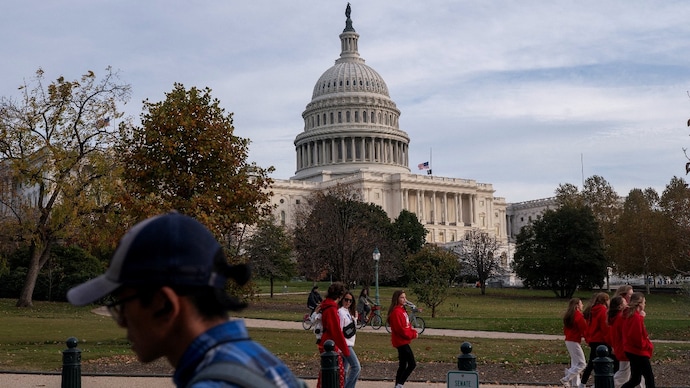
washington, D.C.: The U.S. Senate has advanced a key procedural bill to end the 40-day-long government shutdown, the longest in the nation’s history, which has disrupted air travel, halted food aid programs, and left thousands of federal employees without pay. The Senate voted 60–40 on Sunday night to move the bill forward – but the decision has caused a rift among Democrats, who view it as a compromise on critical healthcare provisions.
The breakthrough came after moderate Democrats reached an agreement with Republican leaders and the White House to proceed without a guaranteed extension of healthcare subsidies. The move has angered progressives, who call it a betrayal of core Democratic values.
The compromise deal was reportedly negotiated by Senators Maggie Hassan and Jeanne Shaheen of New Hampshire, and Independent Senator Angus King of Maine. However, Senate Minority Leader Chuck Schumer broke ranks with his colleagues, voting against the measure in protest.
Key Provisions of the Senate Bill
The proposed legislation aims to reopen the government and halt President Donald Trump’s plan to downsize the federal workforce. It would prohibit federal agencies from conducting layoffs until January 30, 2026.
At the beginning of Trump’s second term, approximately 2.2 million civilians were employed by the federal government. Under the president’s downsizing initiative, nearly 300,000 workers were expected to leave their jobs by year’s end. The new bill seeks to stop those cuts and provide financial relief to affected employees.
| Key Aspects of the Shutdown Bill | Details |
|---|---|
| Bill Status | Advanced by U.S. Senate (60–40 vote) |
| Duration of Shutdown | 40 days – the longest in U.S. history |
| Workforce Protection | No federal layoffs until January 30, 2026 |
| Healthcare Subsidies | Omitted from current agreement, causing Democratic rift |
| Negotiators | Senators Hassan, Shaheen, and King |
| Next Steps | Further Senate votes → House approval → Presidential signature |
Relief for Federal Workers
Under the new proposal, all federal employees – including members of the armed forces, Border Patrol agents, and air traffic controllers – would receive full back pay. This clause aims to compensate workers affected by the shutdown’s financial toll.
Republican leaders intend to modify the bill further to incorporate a full-year funding package negotiated with moderate Democrats. Once the remaining procedural hurdles are cleared, the legislation will move to the House of Representatives for final approval before being sent to the President’s desk.
Democratic Backlash Over Healthcare Subsidies
The healthcare subsidy issue has become the most contentious point in the debate. The bill’s failure to include a guaranteed extension of Affordable Care Act (ACA) subsidies has drawn sharp criticism from Democratic lawmakers.
Senate Minority Leader Chuck Schumer expressed deep frustration, saying he could not “in good faith” support a measure that leaves millions vulnerable. “Our party has sounded the alarm on healthcare,” Schumer said after two hours of debate. “We will not give up the fight.”
Echoing his sentiment, Democrat Chris Murphy argued that recent elections showed voters wanted Democrats to remain united, while Senator Bernie Sanders condemned the compromise as a “horrific mistake.”
Trump’s Push for Direct Payments
The standoff in Congress comes amid President Trump’s renewed push to replace ACA subsidies with direct payments to individuals. These subsidies, credited with doubling ACA enrollment to 24 million Americans since 2021, have become a major flashpoint between the parties.
Republicans argue that the subsidy debate should resume only after the government is reopened. “I stand ready to work with both parties to solve this problem once the government is open,” Trump said in a statement from the White House.
However, on his Truth Social platform, Trump attacked the ACA subsidies, calling them a “windfall for Health Insurance companies and a disaster for the American people.” He insisted that funds should go directly to citizens instead.
What Happens Next?
With the procedural vote passed, the bill now heads through further Senate motions before being sent to the House. Lawmakers opposed to the compromise could still delay these steps, but Republican and moderate Democratic leaders are confident of final approval.
Once signed into law, the bill will restore government funding through January 2026, reopen shuttered agencies, and release back pay to millions of employees.
Conclusion
The Senate’s move to end the 40-day shutdown marks a turning point in a political standoff that has strained America’s economy and divided Congress. While the agreement promises relief for millions of federal workers, the split among Democrats over healthcare subsidies highlights enduring divisions within the party.
As the bill advances toward final passage, Democrats and Republicans remain at odds over the future of healthcare funding, setting the stage for another round of fierce debate in Washington.
For breaking news and live news updates, like us on Facebook or follow us on Twitter and Instagram. Read more on Latest World on thefoxdaily.com.






COMMENTS 0